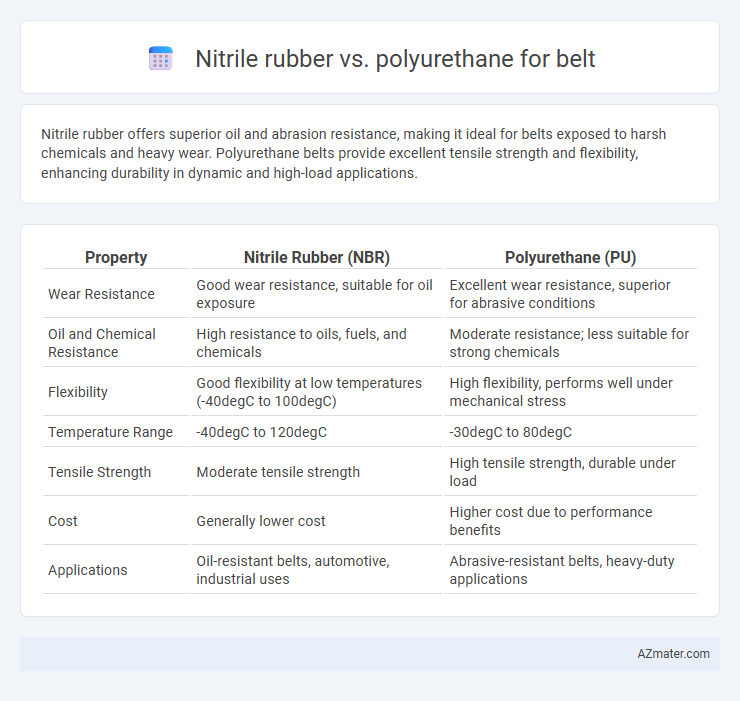Nitrile rubber offers superior oil and abrasion resistance, making it ideal for belts exposed to harsh chemicals and heavy wear. Polyurethane belts provide excellent tensile strength and flexibility, enhancing durability in dynamic and high-load applications.
Table of Comparison
| Property | Nitrile Rubber (NBR) | Polyurethane (PU) |
|---|---|---|
| Wear Resistance | Good wear resistance, suitable for oil exposure | Excellent wear resistance, superior for abrasive conditions |
| Oil and Chemical Resistance | High resistance to oils, fuels, and chemicals | Moderate resistance; less suitable for strong chemicals |
| Flexibility | Good flexibility at low temperatures (-40degC to 100degC) | High flexibility, performs well under mechanical stress |
| Temperature Range | -40degC to 120degC | -30degC to 80degC |
| Tensile Strength | Moderate tensile strength | High tensile strength, durable under load |
| Cost | Generally lower cost | Higher cost due to performance benefits |
| Applications | Oil-resistant belts, automotive, industrial uses | Abrasive-resistant belts, heavy-duty applications |
Introduction to Belt Materials: Nitrile Rubber vs Polyurethane
Nitrile rubber and polyurethane are prominent materials used in belt manufacturing, each offering distinct properties suited for specific applications. Nitrile rubber excels in oil resistance, flexibility, and temperature tolerance, making it ideal for industrial belts exposed to harsh chemicals and dynamic movements. Polyurethane provides superior abrasion resistance, load-bearing capacity, and longevity, which benefits conveyor belts and timing belts requiring high durability and precise mechanical performance.
Key Properties of Nitrile Rubber Belts
Nitrile rubber belts exhibit excellent resistance to oils, fuels, and chemicals, making them ideal for environments exposed to petroleum-based products. Their superior abrasion resistance and high tensile strength ensure durability under continuous mechanical stress and harsh operating conditions. Temperature resistance typically ranges from -30degC to 100degC, allowing stable performance in both cold and moderately high-temperature applications.
Key Properties of Polyurethane Belts
Polyurethane belts exhibit superior abrasion resistance and enhanced flexibility compared to nitrile rubber belts, making them ideal for high-wear industrial applications. Their excellent resistance to oils, greases, and chemicals ensures prolonged durability in harsh environments, while their high tensile strength supports heavy load handling without stretching. Polyurethane's low deformation and resistance to tear provide reliable performance and long service life in conveyor and power transmission systems.
Durability Comparison: Nitrile Rubber vs Polyurethane
Nitrile rubber belts exhibit excellent resistance to oils, fuels, and abrasion, making them highly durable in harsh industrial environments. Polyurethane belts outperform nitrile in terms of tensile strength, abrasion resistance, and flexibility, offering superior wear life and load-carrying capacity. While nitrile rubber excels in chemical exposure, polyurethane delivers enhanced durability and longevity under heavy mechanical stress and dynamic conditions.
Chemical Resistance: Nitrile Rubber vs Polyurethane
Nitrile rubber exhibits superior chemical resistance to oils, fuels, and hydrophobic substances, making it ideal for belts exposed to petroleum-based chemicals. Polyurethane offers enhanced resistance to abrasion, hydraulic fluids, and aliphatic hydrocarbons, providing durability in harsh mechanical environments. Both materials resist different chemical agents, with nitrile excelling against oils and polyurethanes performing better with solvents and mechanical stress.
Temperature Performance and Stability
Nitrile rubber offers excellent temperature resistance, typically performing effectively between -40degC to 120degC, making it suitable for applications with moderate heat exposure. Polyurethane belts withstand a broader temperature range, from approximately -40degC to 90degC, but excel in maintaining mechanical stability and abrasion resistance under thermal cycling conditions. The superior heat-aging properties of nitrile rubber contrast with the enhanced wear and dimensional stability of polyurethane, influencing belt longevity based on specific thermal environments.
Flexibility and Mechanical Strength
Nitrile rubber offers excellent flexibility and superior resistance to oil and chemicals, making it ideal for belts in environments with exposure to lubricants. Polyurethane belts exhibit outstanding mechanical strength, high abrasion resistance, and load-bearing capacity, providing enhanced durability under heavy stress and strain. When comparing flexibility, nitrile rubber is more adaptable to dynamic movements, while polyurethane excels in maintaining shape and structural integrity under mechanical pressure.
Cost and Maintenance Considerations
Nitrile rubber belts generally offer a lower initial cost compared to polyurethane belts, making them a cost-effective choice for applications with moderate wear and chemical exposure. Maintenance for nitrile rubber belts involves regular inspection for cracks and degradation due to oil and heat, whereas polyurethane belts require less frequent maintenance because of superior abrasion resistance and longer service life. Choosing between nitrile rubber and polyurethane depends on balancing upfront expenses against long-term maintenance savings and application-specific durability needs.
Applications: Ideal Uses for Nitrile Rubber and Polyurethane Belts
Nitrile rubber belts excel in applications requiring excellent oil, fuel, and chemical resistance, making them ideal for automotive, industrial, and food processing environments. Polyurethane belts offer superior abrasion resistance, high tensile strength, and flexibility, fitting perfectly in material handling, conveyor systems, and packaging industries. Both materials serve distinct purposes, with nitrile belts preferred in harsh chemical conditions and polyurethane belts favored for durability and load-bearing performance.
Choosing the Best Belt Material for Your Needs
Nitrile rubber offers excellent resistance to oils, fuels, and abrasion, making it ideal for industrial belts exposed to harsh chemicals and tough environments. Polyurethane belts provide superior tensile strength, flexibility, and resistance to cuts and impacts, suited for applications requiring high durability and precision. Selecting the best belt material depends on your specific needs for chemical resistance, durability, and flexibility to ensure optimal performance and longevity.

Infographic: Nitrile rubber vs Polyurethane for Belt
 azmater.com
azmater.com